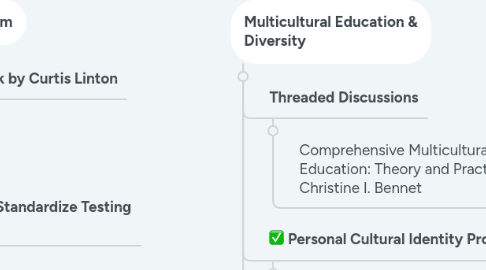
1. Introduction to the MED
1.1. Dispositions Self-Assessment
1.1.1. Reflection
1.2. APA Style Writing Essentials
1.2.1. Pre & Post Assessments
1.3. Instructional Leadership Framework
1.3.1. Signature Assignment
1.3.1.1. Instructional Leadership Definition
1.3.1.2. Coursework
1.3.1.3. Resources
1.3.1.4. Educational Leader & Change Agent Reflection
1.4. ProQuest Ref Works
1.4.1. Sullivan Library overview
2. Introduction to Exceptional Children
2.1. Threaded Discussions
2.1.1. Exceptional Learners: Intro to Special Education 12ed. (2012)
2.1.2. How to Differentiate Instruction in Mixed-Ability Classrooms, 2nd edition
2.2. IDEA 2004 Overview
2.2.1. Individuals with Disabilities Education Improvement Powerpoint
2.2.1.1. History & Evolution
2.2.1.1.1. Timeline
2.2.1.2. IEP
2.2.1.2.1. Essential components/sections
2.2.1.2.2. The role of GenEd teacher
2.2.1.2.3. Qualification Procedures
2.2.1.3. FAPE
2.2.1.3.1. Free Appropriate Public Education
2.2.1.4. LRE
2.2.1.4.1. Service Delivery Setting
2.3. Autism the Musical
2.3.1. Analysis
2.3.1.1. Pre and Post reflection
2.3.1.2. Challenges for parents and teachers
2.4. Differentiation Plan
2.4.1. Signature Assignment
2.4.1.1. Evidence-based strategies and accommodations
2.4.1.2. Differentiation plan commentary
2.4.1.3. Assessment for different learners
2.5. English Language Learners
2.5.1. Seven Teaching Strategies for Classroom Teachers of ELLs by Judie Haynes
2.5.1.1. Lesson Plan implementing two of the seven strategies
3. Teaching Strategies: Secondary
3.1. UbD Unit Planning Framework
3.1.1. Stage 1—Identify Desired Results
3.1.2. Stage 2—Determine Acceptable Evidence
3.1.3. Stage 3—Plan Learning Experiences and Instruction Accordingly
3.2. Time Management
3.3. Vocabulary Instruction
3.4. UbD Unit Plan
3.4.1. Signature Project
3.4.1.1. Things Fall Apart by Chinua Achebe
3.4.1.2. Bloom taxonomy
3.5. Applying Concepts in the Classroom
3.5.1. Summary Rubric
3.5.2. Summary Example
3.5.3. Think as You Read Strategy
3.5.4. Reading Annotation Protocol
3.5.5. EES Lesson Plan
3.5.6. Writing Lesson
4. Secondary English Methods
4.1. CCSS
4.1.1. Creating Text Dependent Questions for Close Analytic Reading
4.1.2. Shifts in the CCSS
4.1.2.1. Text complexity
4.1.2.2. Analyze, Infer, Give Evidence
4.1.2.3. Writing to sources
4.1.2.4. Research
4.1.2.5. Academic Vocabulary
4.1.3. Reflection
4.1.3.1. Discussions
4.2. Unit Texts Analysis
4.2.1. Fiction
4.2.1.1. Literary Texts
4.2.2. NonFiction
4.2.2.1. Informational Texts
4.3. CCSStandards Unit Plan
4.3.1. Signature Assignmet
4.3.1.1. Literary Book: Animal Farm
4.3.1.2. Informational Texts
4.3.1.2.1. Solzhenitsyn, A. (2017, January 28). One World of Truth Outweighs the World. Speech.
4.3.1.2.2. Wiesel, E. (1986, December 11). Hope, Despair, and Memory. Speech.
4.3.1.2.3. Time to Assert American Values [Editorial]. (n.d.). The New York Times
4.3.1.2.4. Reyes, A. Rough Justice: A Canning in Singapore Stirs Up a Fierce Debate About Crime and Punishment.
4.3.1.3. Assessment Tools
4.3.1.3.1. Writing Lesson Plan
4.3.1.3.2. Speaking & Listening Collaborative Lesson
5. Peace, Justice & Ed Reform
5.1. The Equity Framework by Curtis Linton
5.1.1. Book Analysis
5.1.2. Discussions
5.2. Support Systems for Standardize Testing Research
5.2.1. Signature Project
5.2.1.1. Advocacy through support systems
5.2.1.1.1. ACT Test Support
5.2.1.1.2. SBAC Test Support
5.2.1.2. Focus
5.2.1.2.1. Classroom culture
5.3. Educational change
5.3.1. Vision & Goals
5.3.1.1. School
5.3.1.2. Classroom
5.3.1.3. Community
5.3.1.4. State & National levels
5.4. Threaded Discussions:
5.4.1. Peace and Justice theories
5.4.2. Principles
5.4.3. Research related to educational reform
6. Multicultural Education & Diversity
6.1. Threaded Discussions
6.1.1. Comprehensive Multicultural Education: Theory and Practice by Christine I. Bennet
6.2. Personal Cultural Identity Project
6.2.1. Elder Interview
6.2.1.1. Family History
6.2.1.2. Presentation with reflections
6.2.1.3. Cultural Values
6.3. Cultural Activity
6.3.1. A Gathering with Colleagues
6.3.1.1. Analysis with Reflection
6.4. Becoming a Culturally Competent Educator
6.4.1. Signature Assignment
6.4.1.1. Final Reflection
6.5. Applying Concepts in the Classroom
6.5.1. Elder Interview: Personal Cultural Identity Project
7. Hawaiian Culture and Language
7.1. Hoʻoulu: Our time of becoming Hawaiian epistemology and early writings of Manulani Aluli Meyer
7.1.1. Manulani Aluli Meyer (2003)
7.1.2. Threaded Discussions
7.2. Hawaiian History
7.2.1. Diversity of Cultures
7.2.2. Cultural/political significance of indigenous languages
7.3. ʻŌlelo Hawaiʻi
7.3.1. Ka Leo ʻŌiwi Learning Series
7.3.2. Language worksheet
7.3.3. Threaded Discussions
7.4. Place-Based Multicultural Pedagogy
7.4.1. Signature Assignment
7.4.1.1. Signature Project Brainstorm
7.4.1.2. Nā Hopena A'o (HĀ) Framework
7.4.1.2.1. Belonging
7.4.1.2.2. Responsiblity
7.4.1.2.3. Excellence
7.4.1.2.4. Aloha
7.4.1.2.5. Total Well-Being
7.4.1.2.6. Hawaii
7.4.1.3. Long-Term Plan
7.4.1.3.1. Google Doc
7.4.1.3.2. Google Site
7.4.1.4. Focus
7.4.1.4.1. Hana
7.4.1.4.2. ʻOhana | Community
7.4.1.4.3. Hana | Self
7.5. 'ŌLELO NO'EAU / PROVERBS
7.5.1. Analysis
7.5.2. Discussions
7.5.3. Reflections
8. Ed Technology in the Classroom
8.1. Threaded Discussions
8.1.1. Educational Philosophy Discussion
8.1.2. ISTE Standards Discussion
8.1.3. Technology Integration Discussion
8.1.4. Lesson Plan Discussion
8.1.5. Integrating educational technology into teaching (7th ed.).
8.1.5.1. Roblyer, M. D., & Doering, A. H. (2015)
8.2. Technology Tools for 21st Century Teaching
8.2.1. Individual Project
8.2.1.1. Foundations for Effective Technology Integration
8.2.1.2. Lesson plan
8.2.1.3. Powerpoint
8.3. edTPA Video Project
8.3.1. Teaching Video
8.3.1.1. Reflection
8.3.2. InTASC Standards
8.4. Professional ePortfolio
8.4.1. Background Information
8.4.1.1. Resume
8.4.1.2. Teaching Context
8.4.1.3. Educational Philosophy
8.4.1.4. Teaching Goals
8.4.2. Teaching artifacts and Reflections
8.4.2.1. unit goals
8.4.2.2. Instructional Plan
8.4.2.3. Resources used in unit
8.4.3. Professional Information
8.4.3.1. list of professional activities
8.4.3.2. letters of recommendation
8.4.3.3. formal evaluations
8.5. Technology Plan Grant Proposal
8.5.1. Signature Assignment
8.5.1.1. Introduction
8.5.1.1.1. Mission statement
8.5.1.2. Goals and Objectives
8.5.1.3. Resources needed
8.5.1.4. Training & Maintance
8.5.1.5. Future goals
8.5.1.6. Student Assessment
8.5.1.7. Concluding Remarks: ISTE standards
9. Educational Research & Design
9.1. The National Institute of Health Office of Extramural Research
9.1.1. Human Subjects Certification
9.2. Research Proposal
9.2.1. Social and Emotional Learning
9.2.1.1. Annotated Bibliography
9.2.1.2. Literature Review
9.2.1.3. Methodology
